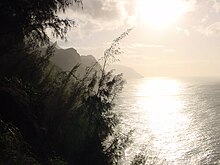Human interrelationship

Although humans comprise only a minuscule proportion of the total living biomass on Earth, the human effect on nature is disproportionately large. Because of the extent of human influence, the boundaries between what humans regard as nature and "made environments" is not clear cut except at the extremes. Even at the extremes, the amount of natural environment that is free of discernible human influence is diminishing at an increasingly rapid pace.
The development of technology by the human race has allowed the greater exploitation of natural resources and has helped to alleviate some of the risk from natural hazards. In spite of this progress, however, the fate of human civilization remains closely linked to changes in the environment. There exists a highly complex feedback loop between the use of advanced technology and changes to the environment that are only slowly becoming understood. Man-made threats to the Earth's natural environment include pollution, deforestation, and disasters such as oil spills. Humans have contributed to the extinction of many plants and animals.
Humans employ nature for both leisure and economic activities. The acquisition of natural resources for industrial use remains a sizable component of the world's economic system. Some activities, such as hunting and fishing, are used for both sustenance and leisure, often by different people. Agriculture was first adopted around the 9th millennium BCE. Ranging from food production to energy, nature influences economic wealth.
Although early humans gathered uncultivated plant materials for food and employed the medicinal properties of vegetation for healing, most modern human use of plants is through agriculture. The clearance of large tracts of land for crop growth has led to a significant reduction in the amount available of forestation and wetlands, resulting in the loss of habitat for many plant and animal species as well as increased erosion.
Aesthetics and beautyedit
Beauty in nature has historically been a prevalent theme in art and books, filling large sections of libraries and bookstores. That nature has been depicted and celebrated by so much art, photography, poetry, and other literature shows the strength with which many people associate nature and beauty. Reasons why this association exists, and what the association consists of, are studied by the branch of philosophy called aesthetics. Beyond certain basic characteristics that many philosophers agree about to explain what is seen as beautiful, the opinions are virtually endless. Nature and wildness have been important subjects in various eras of world history. An early tradition of landscape art began in China during the Tang Dynasty (618–907). The tradition of representing nature as it is became one of the aims of Chinese painting and was a significant influence in Asian art.
Although natural wonders are celebrated in the Psalms and the Book of Job, wilderness portrayals in art became more prevalent in the 1800s, especially in the works of the Romantic movement. British artists John Constable and J. M. W. Turner turned their attention to capturing the beauty of the natural world in their paintings. Before that, paintings had been primarily of religious scenes or of human beings. William Wordsworth's poetry described the wonder of the natural world, which had formerly been viewed as a threatening place. Increasingly the valuing of nature became an aspect of Western culture. This artistic movement also coincided with the Transcendentalist movement in the Western world. A common classical idea of beautiful art involves the word mimesis, the imitation of nature. Also in the realm of ideas about beauty in nature is that the perfect is implied through perfect mathematical forms and more generally by patterns in nature. As David Rothenburg writes, "The beautiful is the root of science and the goal of art, the highest possibility that humanity can ever hope to see".:281
Comments
Post a Comment